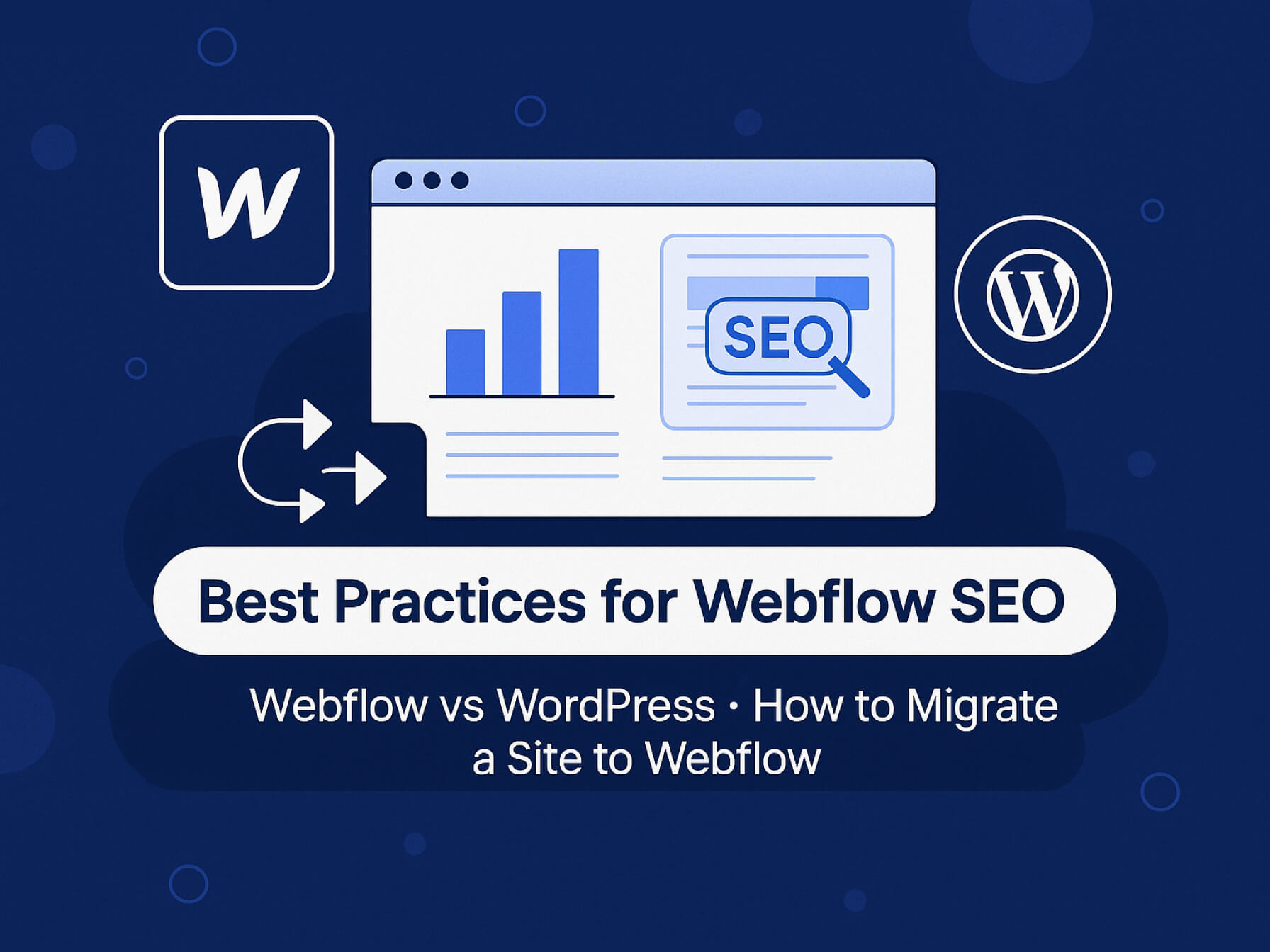Why Webflow is More Than Just a Visual Builder
In today’s digital space, businesses want sleek design without sacrificing speed or SEO. That’s where Webflow excels. As a no-code, fully customizable CMS platform, it gives complete creative control with clean code and fast performance. But many still ask:
- Is Webflow SEO-friendly?
- Is it better than WordPress?
- Can I migrate my site without losing traffic or ranking?
Let’s dive into these questions and share real best practices from the field.
1. Webflow SEO Best Practices
Even though Webflow is SEO-ready out of the box, you still need to optimize correctly. Here are proven practices:
Clean HTML structure
Using a clear and semantic HTML structure is crucial for both SEO and accessibility. Webflow allows full control over the structure of your site, so take advantage of semantic tags such as <header>, <main>, <section>, <article>, and <footer>. These tags help search engines understand the purpose of each section of your content, improving indexing accuracy. Avoid unnecessary div nesting, as it not only bloats your code but can also make it harder for screen readers and crawlers to interpret the page hierarchy. Clean code contributes to faster load times and better user experience.
Customizable Meta Titles & Descriptions
Every page on your Webflow site should have a unique and descriptive meta title and meta description. These are managed within the Page Settings or can be dynamically generated using CMS templates for blog posts or project pages. Optimized meta tags improve click-through rates in search engine results and help Google better understand your content. Use your target keywords naturally, keep titles under 60 characters, and descriptions under 160 characters for best display in SERPs.
Heading Hierarchy
Heading tags (<h1> to <h6>) provide structure to your content and help search engines understand what your page is about. Always use a single <h1> tag per page, typically for the main title. Subtopics should use <h2>, and further subsections should follow a descending order (<h3>, <h4>, etc.). Avoid skipping levels (e.g., jumping from H1 to H4) to maintain logical structure. A well-structured heading hierarchy improves accessibility and readability for both users and bots.
Canonical Tags
Canonical tags prevent duplicate content issues by telling search engines which version of a page is the "master" copy. This is especially important if similar content exists at multiple URLs, such as paginated pages or filtered views. In Webflow, you can add canonical tags manually in the page <head> via the Custom Code section. Always set a canonical URL that matches the primary page you want indexed to consolidate ranking signals and avoid keyword cannibalization.
Open Graph + Social Meta Tags
Open Graph (OG) tags are essential for controlling how your content appears when shared on social media platforms like Facebook, LinkedIn, and Twitter (which uses Twitter Cards). In Webflow, you can specify OG images, titles, and descriptions for each page. A well-crafted OG preview increases the likelihood of link clicks and drives more engagement from social traffic. Ideally, the OG image should be 1200x630 pixels and visually reflect the content of the page.
Clean URL Slugs
URL slugs should be concise, keyword-relevant, and readable by both humans and search engines. Webflow allows full control over your URLs, so always remove unnecessary words, stop words, or redundant terms. For example:
- Bad:
/about-us-our-team-company - Good:
/about
Keep URLs lowercase, use hyphens instead of underscores, and avoid using special characters or dates unless absolutely necessary. Clean URLs also increase user trust and CTR in search results.
Image Optimization
Images are essential for visual appeal but can severely impact load times if not optimized. In Webflow:
- Use modern formats like WebP which offer smaller file sizes without compromising quality.
- Add descriptive ALT tags to every image for accessibility and SEO—search engines use these to understand image content.
- Enable lazy loading so images load only when they appear in the user's viewport, reducing initial page load time and improving Core Web Vitals.
Well-optimized images contribute to faster load speeds, better rankings, and a smoother user experience across devices.
2. Webflow vs. WordPress: Pros & Cons
🧠 Tip: For most modern businesses, Webflow wins on speed, simplicity, and design flexibility. But WordPress still makes sense for massive blogs or plugin-heavy features.
3. Migrating Your Site to Webflow Without SEO Loss
A common fear: “Will I lose traffic if I move to Webflow?”
The answer: not if you migrate strategically. Here’s how:
🧩 Step 1: Audit Existing Pages
- Export a full list of your current URLs (Screaming Frog or Ahrefs)
- Identify top-performing content (Google Analytics / Search Console)
🔁 Step 2: Set Up 301 Redirects
- Use Webflow’s built-in 301 Redirects tool
- Map every old URL to its new equivalent
- Avoid 404s at all costs
🛠 Step 3: Match Meta Titles, Alt Tags & Headers
- Recreate meta tags exactly (or improve them slightly)
- Maintain heading structure to preserve ranking signals
🌐 Step 4: Submit Updated Sitemap
- Generate Webflow’s sitemap.xml
- Submit it via Google Search Console
- Monitor crawl errors and index status
📈 Step 5: Track Everything
Set up Google Analytics 4 + GSC + Facebook Pixel if needed. Use UTM parameters to track traffic shifts.
🎯 PRO TIP: Always migrate during low-traffic periods and announce the change via newsletter/socials to regain momentum.
Conclusion: Webflow is Your Growth Partner, Not Just a CMS
Webflow gives entrepreneurs, startups, and agencies the freedom to move faster—without cutting corners on SEO or performance. Whether you're building from scratch or planning a migration, following best practices ensures you not only retain your visibility but accelerate your growth.
📩 Want Help Migrating or Optimizing Your Webflow Site?
Book a free strategy call and get a personalized roadmap for your business website, SEO, or CRO goals.
👉 Schedule your free consultation
